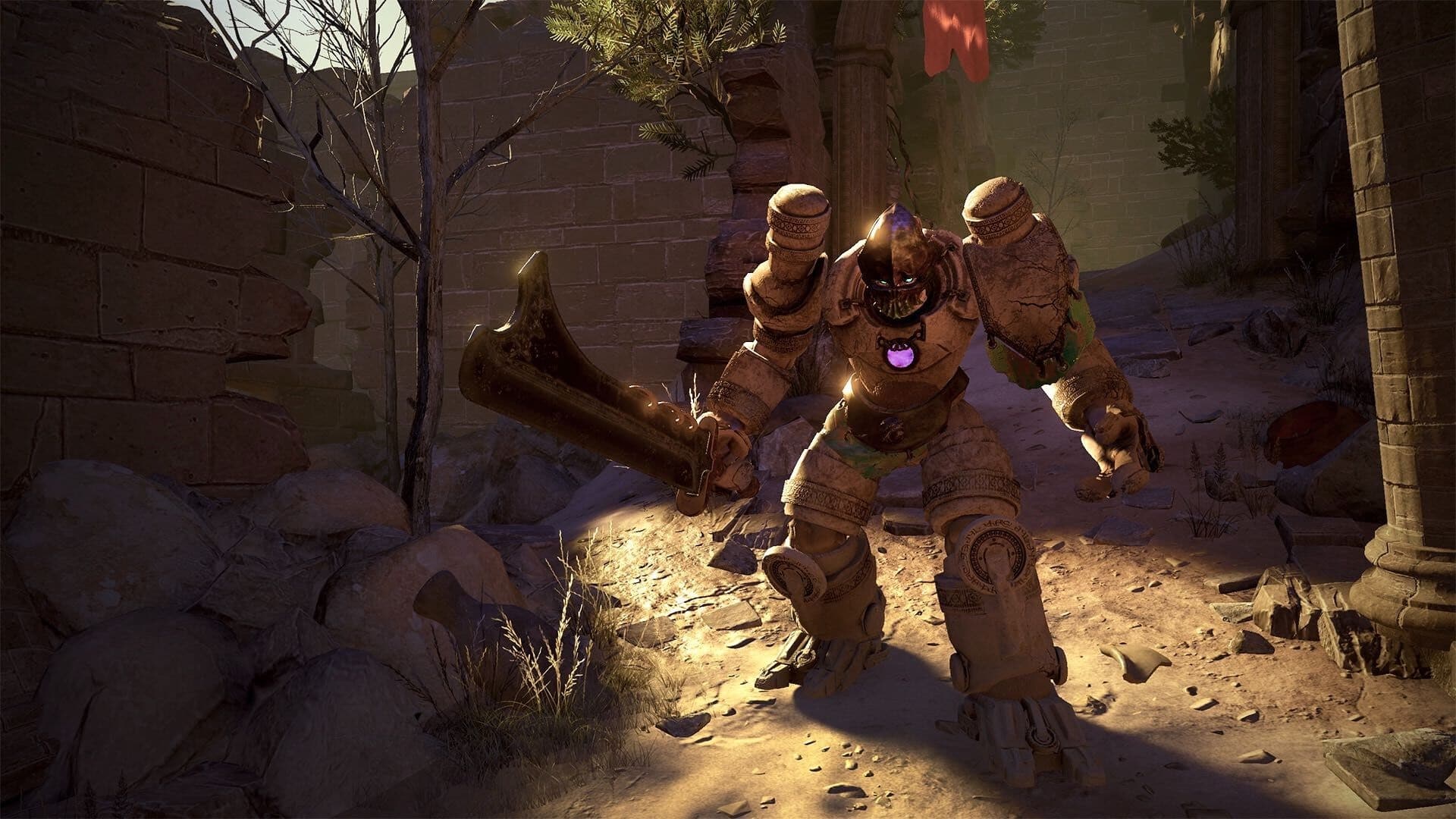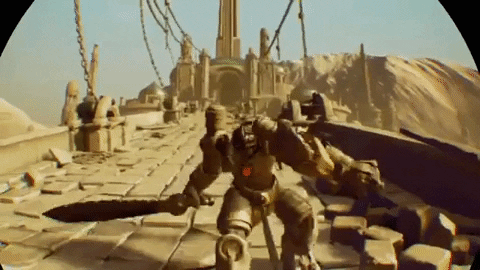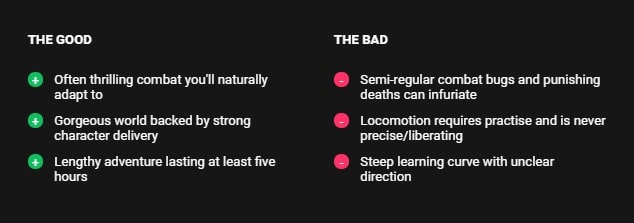Your first few hours of Golem might be agonizing. You might, as I did, wrestle with the game’s troublesome locomotion systems, which appear sluggish and imprecise, lacking the instinctual reactions its combat seems to demand. You might encounter some enemies that are less forgiving of the occasional bugs, which can set you back 15 to 20 minutes of gameplay without it ever being clear if you got something wrong, or the game did. You might, as I was, be nearly ready to give up.
But, with persistence, you can mostly overcome Golem’s shaky start. Though far from perfect, it’s movement options start to feel more natural and manageable the more you play. Slowly but surely, you become more accustomed to its combat which offers a rare heft of effort and even rarer sense of achievement when it works. You’ll play long stretches of the game where its early issues seem to have all but disappeared. Inevitably, though, you’ll come crashing back into them from time-to-time.
The enormous stone monsters you commandeer in Highwire Games’ long-delayed debut appear to be a cunning allegory for the current state of VR. They’re plodding and lumbering, majestic when they work and hopelessly clumsy when they make mistakes. You control these behemoths from afar, playing as a young girl name Twine. She’s confined to her room following a tragic accident but discovers the ability to possess Golems, using her newfound talent to go beyond her four walls and explore the ruins of an ancient city.
Your first thoughts when jumping into the game will probably be of pleasant surprise. Golem is absolutely gorgeous; a game of dusty abandoned landscapes, appreciated minute details and some of the best character models I’ve seen in VR. The striking vistas and impressively involved voice acting had me sitting up to pay attention to the occasional lore drops you’ll find throughout, even if the story ultimately appears to be the first act of something bigger. Special mention also goes to Marty O’Donnell’s Hollywood-like score, which seems to tell a story of its own with its wistful enthusiasm.
Making a less successful first impression is the movement, which offers two modes. Highwire is clearly proud of its Incline system, which has you holding the trigger on a single Move controller and then making small, subtle leans and twists to march forwards and backwards. For the more traditional player though, there’s the ability to play with the DualShock 4 in one hand (Update: we originally said the game supports the PlayStation Navigation control based on a tweetbased on a tweet from the creative director. We now hear you can’t use the controller. Our apologies for the mistake.) to use the analog stick instead.
To be frank, neither system is perfect and you might well start out hating both. Once you gather momentum, the slight tilts and turns used to navigate the Incline system can come quite naturally, provided your path is wide. But once you come to a stop, as you often will, it’s a lofty mental process to get started up again in the right direction. There’s some tossing and tussling involved until you start clambering off in a way that feels right again, which is a constant distraction.
Not to mention that the gliding turns you’ll take when twisting your head can feel very uncomfortable (there are, however, generous and thoroughly immersive blinder options). After a few hours of the game, I’d overcome this tricky learning curve, but there were still plenty of tight situations where the navigation just doesn’t deliver the precision you’d hope. Not only that, it’s almost impossible to take in and enjoy your surroundings as you move.
You will, eventually, get there, but the game isn’t interested in helping you much. In fact, Golem is a strangely ambiguous experience at times, providing you with only a very basic early tutorial and then forcing you to learn the ropes by yourself. There’s no map to help you navigate and memorize the innards of the city, which at one point had me wandering aimlessly around for hours until I finally located a staircase I’d missed closer to the start. Given you’re so slow on your feet, trekking from one end of the map to the other often comes off as a chore.
Almost inexplicably, the same is true of your inventory system, which is one of the game’s most puzzling elements. Every time you kill another Golem, you collect its weapon, life gem and mask. Gems have different health benefits while masks open different doors. To equip any of them, or even just check your inventory, you have to scrap your current Golem. That means losing your current gear and restarting back at the game’s central hub and then having to make your way back to your desired destination. So if you pick up a new, more powerful weapon mid-journey, you won’t be able to equip it without having to retrace your steps and refight the same battles to get back to where you were. Sometimes that means tens of minutes of repetition.
The same happens when you die in combat, making some of the game’s battles absolutely infuriating. Fortunately, the vast majority of encounters in Golem are genuinely thrilling, at least once you’re attuned to its systems. It’s similar in design to Vader Immortal; hold your weapon up to block an incoming attack based on the direction of a swing, then take a stab of your own when the enemy is exposed.
But it’s also a war of attrition; the gaps between openings are long and enemies often require a lot of hits to be taken down. With every successful block the stakes are raised and it’s not uncommon to end a fight with your heart thumping, arms aching and a proud sense of victory. Plus, the more confident in combat you become, the more you learn about it, like the need to push forward between swings, close in distance and maximize your hits, or the chances to score last-minute damage by defending sudden attacks. When it works, Golem’s combat can be some of the most rewarding VR.
When it doesn’t work? It can be a nightmare. Sections of the game have almost no sympathy for VR’s unstable foundations. Sometimes weapon blocks go completely unregistered as do your own attacks. This is not a case of a poor tracking setup; Golem is a fuss-free experience in that department, it’s a case of sometimes the exact same movements having completely different outcomes. Check out the GIF below, for example. I raise up my sword to block an enemy. His blade meets mine, but then his attack seems to slow as it drags downward. I didn’t take any damage in this instance, but his attack carried through when the follow-up rebounds away.
In most encounters, these issues are damning, but not fatal. However, the game has a handful of enemies that can kill you in one hit and, frankly, they’re not worth the pain. Fortunately, these guys are all optional and didn’t stop me from getting to the end of the campaign. But, when you lose a battle to a bug/unclear parameters, lose a bunch of your best equipment and are then teleported a ten-minute walk away with three other battles between you and your destination, Golem is almost daring you to stop playing.
Other bugs aren’t as troublesome, but still of note. Smaller spear-throwing enemies are able to toss projectiles through walls, for example, and I got caught in the environment once or twice, costing me a battle. We waited five years for Golem but, if a few more months had meant the removal of these issues, I’d have happily waited.
Golem is a 4/5 action game with a handful of 2/5 design decisions and bugs, frustrating what should be one of PSVR’s best games. It’s an experience you grow with, eventually taming its unwieldy locomotion and learning the ins and outs of the combat system. By the end of the experience, I finally felt in stride with its intricacies, learning when to press the attack and when to hold back. But the game’s needless desire to brutally punish your mistakes paired with occasional combat bugs that are annoying at times and unforgivable in others had me torn throughout. When Golem’s working with you, it absolutely shines, but it also has a stubborn desire to test your patience to the absolute limit.
Final Score: 

 3/5 Stars | Just Okay
3/5 Stars | Just Okay
Golem is available for EU PSVR physically owners now and will be releasing digitally and in the US next week for $39.99. You can also pick up a physical edition.





























